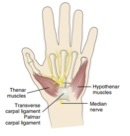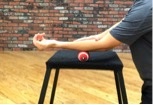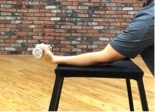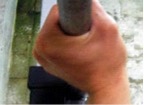Wrist injuries are very common. This is especially true for those on the ice and snow, and also in wheeled sports and activities such as skating and skateboarding in more recent years. In fact, wrist injuries are the second most common type of upper extremity injury. While the majority of wrist injuries are due to falls on an outstretched arm, more overuse wrist problems are occurring that are not directly related to an impact trauma. Carpal tunnel syndrome (CTS) is such a condition.
What is CTS? One of the most common types of nerve entrapments seen in our modern society, CTS occurs when the median nerve is compressed as it passes under the transverse carpal ligament at the wrist (Fig 1). It is frequently the result of repeating the same motions over and over. Excessive wrist hyperextension, such as when using a non-ergonomic keyboard, is one of the leading causal factors of CTS. The angle in this position decreases the space in the wrist and increases pressures applied to the median nerve. Additionally, the condition is easily exacerbated by movement of the fingers, such as on a keyboard, causing the tendons to slide back and forth through the hyperextended wrist.
 Figure 1. Wrist anatomy
Figure 1. Wrist anatomy
The most commonly reported symptoms of CTS are numbness and tingling in the first two to three fingers of the affected hand and aching in the forearm with occasional pain up towards the shoulder. A physician should help diagnose the condition, but there are a few things to look for if you suspect you have CTS:
- Decreased wrist range of motion—normal wrist movement should include approximately:
- 80° of flexion
- 80° of extension
- Phalen’s Sign Test—reach an arm out in front of you and flex the wrist as far as it will go. Aching and numbness within 60 seconds is a positive sign for CTS
- Shoulder range of motion—especially if the two above tests check out fine, wrist aching, numbness, and tingling may be stemming from brachial plexus compression in or around the shoulder
As with most musculoskeletal-related conditions, conservative approaches begin with stretching and exercise, along with changes in the environment such as modifying hand and wrist positions. Many physicians will prescribe a splint to be worn at night and periodically throughout the day to promote a neutral wrist position. It is common to wear this splint for up to a month and is generally effective for mild CTS.
The assessment should guide exercises selected for CTS. As was stated above, if the wrist demonstrates adequate movement yet the shoulder appears to be tight, then a corrective exercise program for the shoulder should be employed. However, if the wrist flexion/extension assessments indicate a lack of motion, the routine should be wrist specific. While deficits in both flexion and extension are common for CTS, chronic wrist hyperextension usually leads to less than optimal wrist flexion. Therefore, your corrective goals are to increase the length of the wrist extensors and to improve the stability and strength of the wrist flexors.
- Inhibit: SMR from wrist to elbow
 Inhibit
Inhibit - Lengthen: Wrist flexion stretch
 Lengthen
Lengthen - Activate: Wrist flexion
 Activate
Activate - Integrate: Cable rows and cable press. Emphasis on neutral
 Integrate
Integrate
An additional consideration for CTS is the position of the wrist during exercises such as the push-up, bench press, and dumbbell presses. When performing these resistance training exercises, it is common for many people to let their wrist hyperextend under the load (Fig. 2). While this may feel more stable, it significantly increases the chances of wrist problems and it also reduces the effectiveness of the lift.
 Figure 2. Wrist hyperextended under load.
Figure 2. Wrist hyperextended under load.
The time spent in the gym should be focused on achieving your goals, but also on preventing injury. Since CTS has largely been identified as an overuse injury, the goal in the gym should be to reverse the damage done throughout the day. If the wrist has been stuck in a hyperextended position, then attempt to restore range of motion and train with the wrist in neutral. If unable to maintain a neutral wrist during heavy loads, consider a weight lifting glove with a wrist wrap or just the wrist wrap.
Corrective exercise programs are focused on identifying the cause of a problem through movement assessment, designing a program, and implementing that program. The key is using movement to guide exercise selection. In conditions that involve possible nerve entrapment, like CTS, there could be many underlying factors. However, employing an exercise strategy to restore optimal range of motion, strength, and coordination will always be a step in the right direction. Use the corrective exercise approach in conjunction with recommendations from your physician and environmental adjustments to tackle CTS from all directions.
References
Armstrong, A.D., Hubbard, M.C. (Eds.). (2016). Essentials of Musculoskeletal Care 5. Rosemont, IL: American Academy of Orthopaedic Surgeons.
Clark, M.A., Lucett, S.L. (2011). NASM Essentials of Corrective Exercise Training. Baltimore, MD: Lippincott Williams & Wilkins.
Cleland, J.A., & Koppenhaver, S. (2011). Netter’s Orthopaedic Clinical Examination: An evidenced-based approach. (2nd Ed.). Philadelphia, PA: Saunders Elsevier.
Dasilva, M.F., & Dasilva, K.A. (2018). Carpal Tunnel Syndrome. In Ferri’s Clinical Advisor 2018, (p. 259-261).
Parmelee-Peters, K., & Eathorne, S. (2005). The wrist: Common injuries and management. Primary Care, 32(1), 35-70.
















